Abstract
OBJECTIVE--To investigate the alterations in autonomic control of heart rate at high altitude and to test the hypothesis that hypoxaemic stress during exposure to high altitude induces non-linear, periodic heart rate oscillations, similar to those seen in heart failure and the sleep apnoea syndrome. SUBJECTS--11 healthy subjects aged 24-64. MAIN OUTCOME MEASURES--24 hour ambulatory electrocardiogram records obtained at baseline (1524 m) and at 4700 m. Simultaneous heart rate and respiratory dynamics during 2.5 hours of sleep by fast Fourier transform analysis of beat to beat heart rate and of an electrocardiographically derived respiration signal. RESULTS--All subjects had resting hypoxaemia at high altitude, with an average oxyhaemoglobin saturation of 81% (5%). There was no significant change in mean heart rate, but low frequency (0.01-0.05 Hz) spectral power was increased (P < 0.01) at high altitude. Time series analysis showed a complex range of non-linear sinus rhythm dynamics. Striking low frequency (0.04-0.06 Hz) heart rate oscillations were observed during sleep in eight subjects at high altitude. Analysis of the electrocardiographically derived respiration signal indicated that these heart rate oscillations correlated with low frequency respiratory oscillations. CONCLUSIONS--These data suggest (a) that increased low frequency power during high altitude exposure is not simply attributable to increased sympathetic modulation of heart rate, but relates to distinctive cardiopulmonary oscillations at approximately 0.05 Hz and (b) that the emergence of periodic heart rate oscillations at high altitude is consistent with an unstable cardiopulmonary control system that may develop on acute exposure to hypoxaemic stress.
Full text
PDF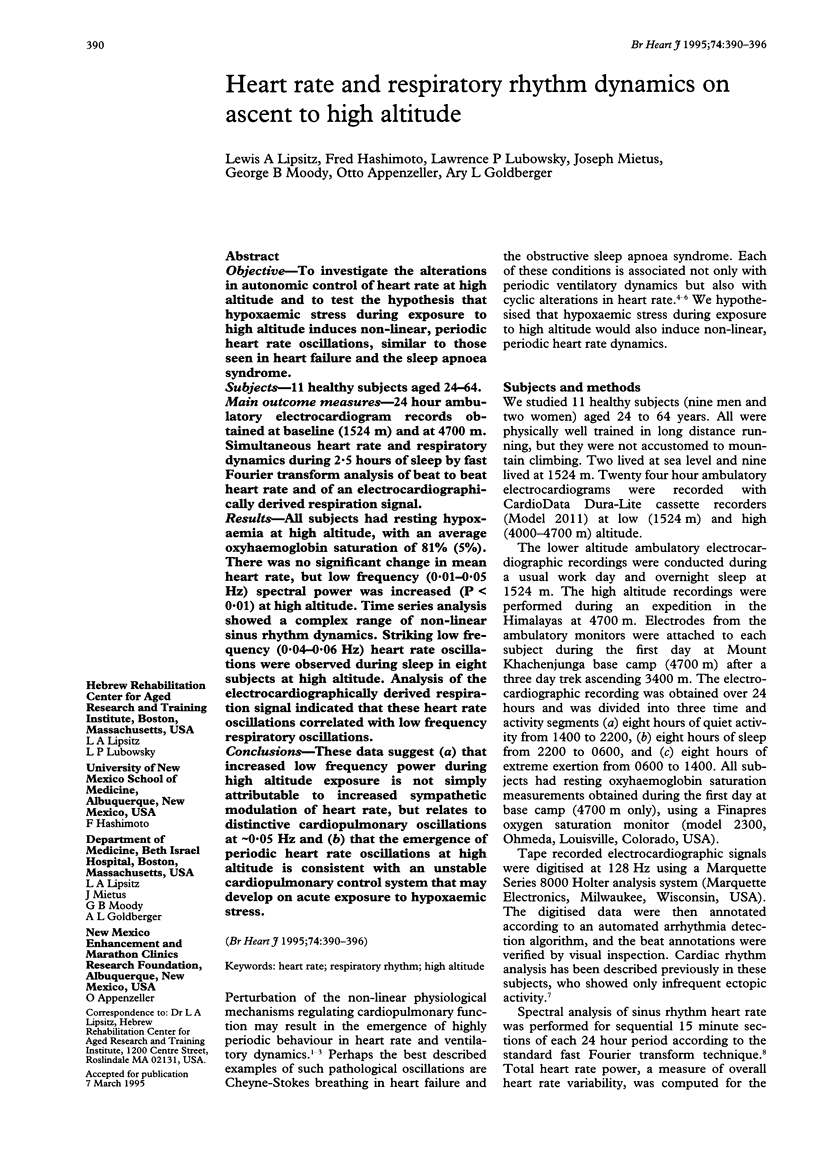
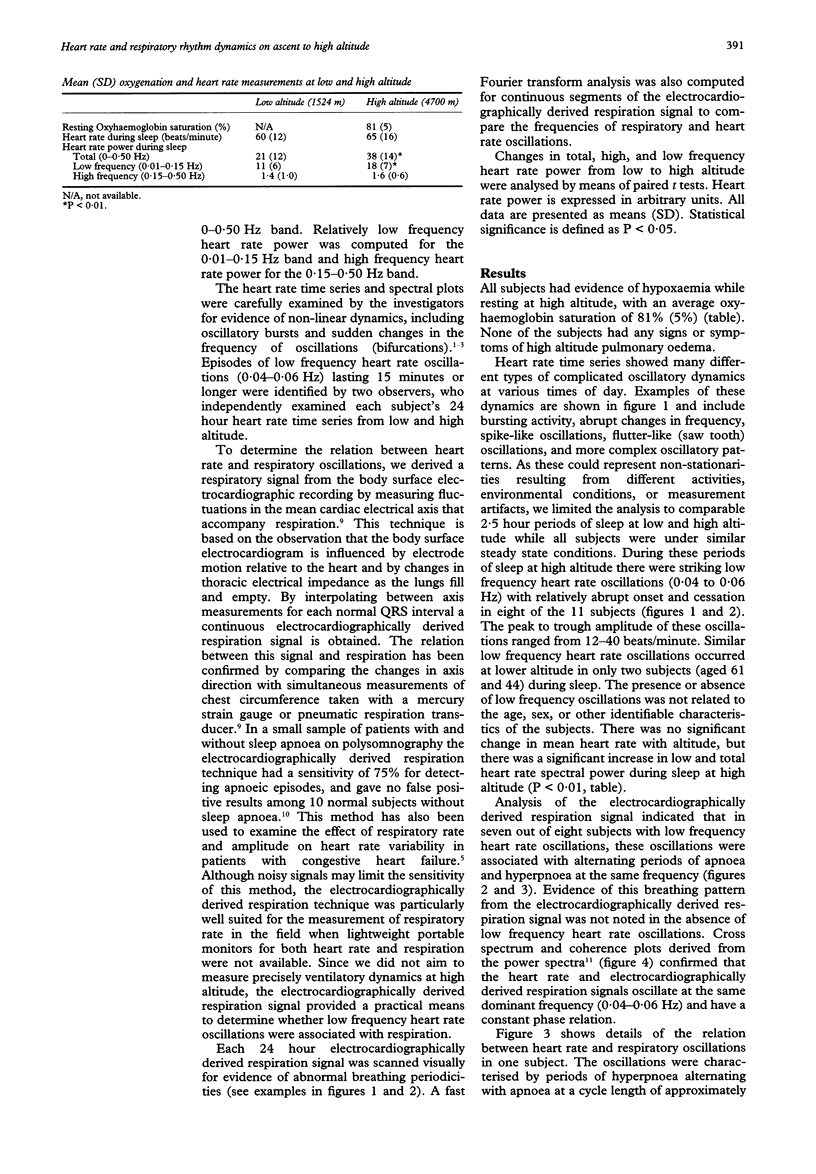
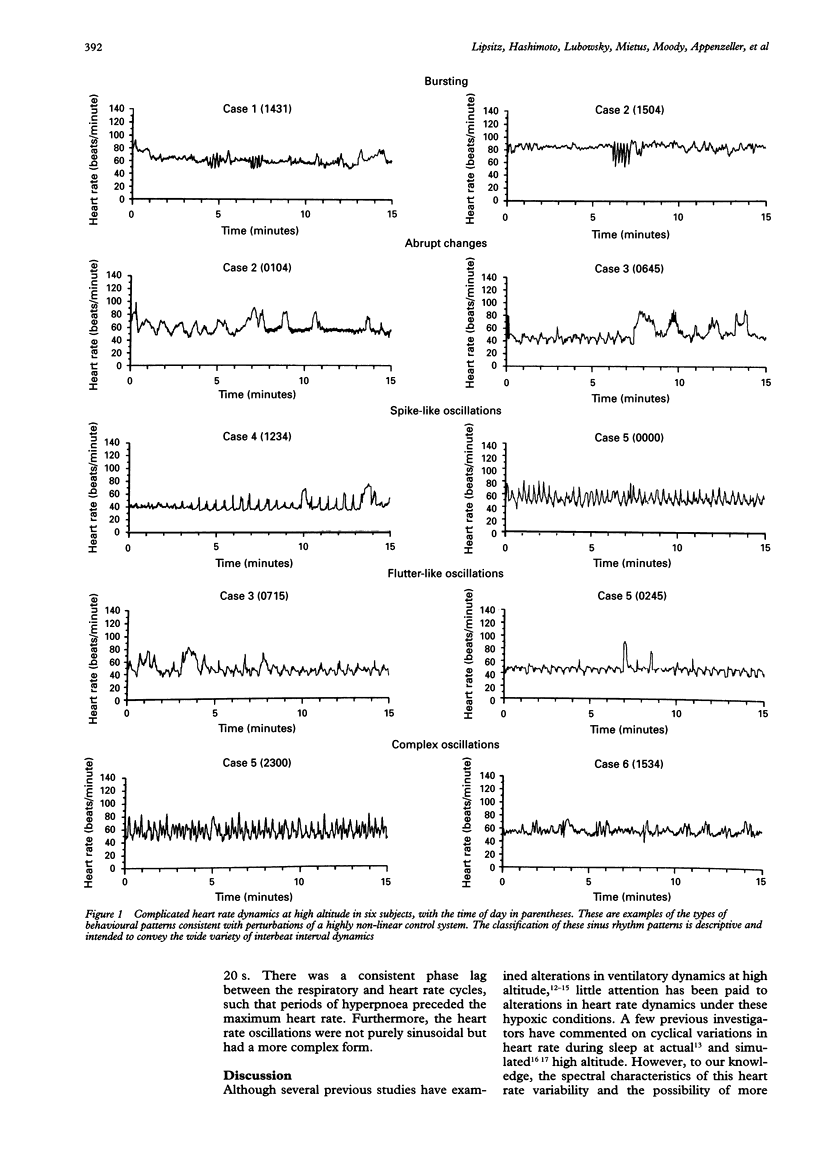
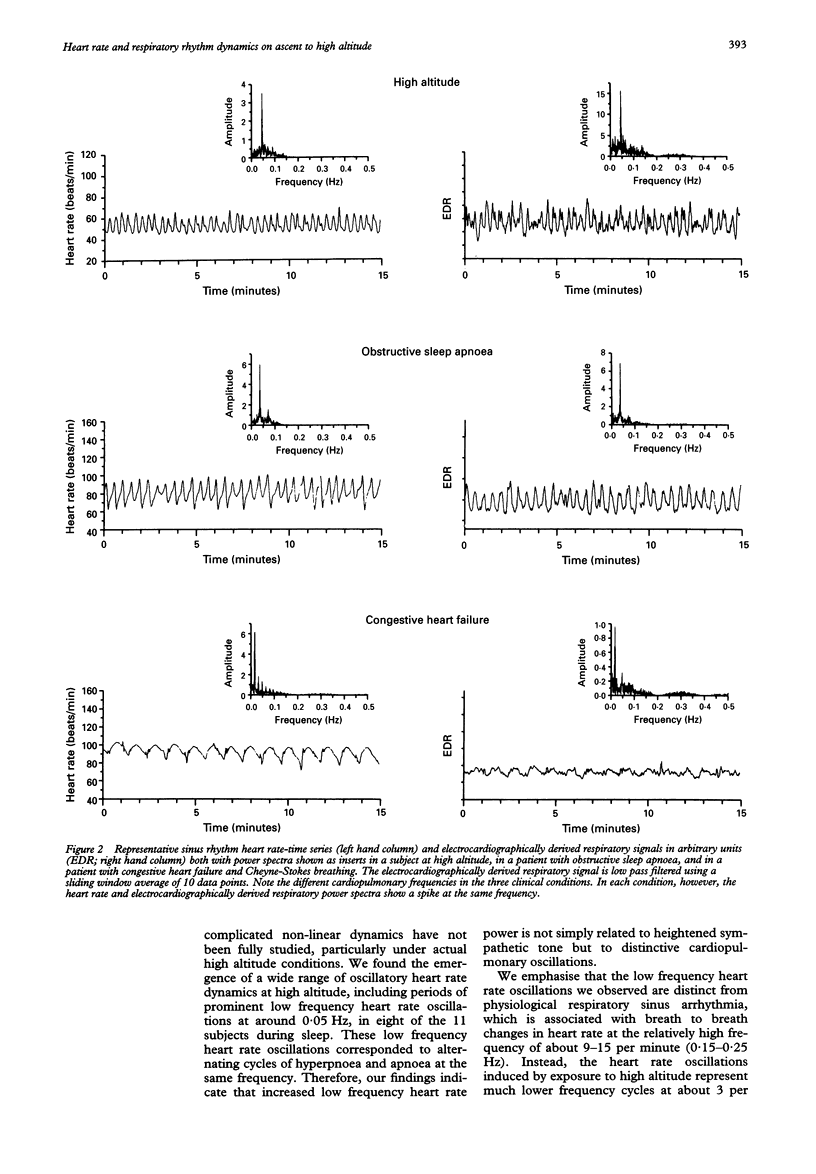
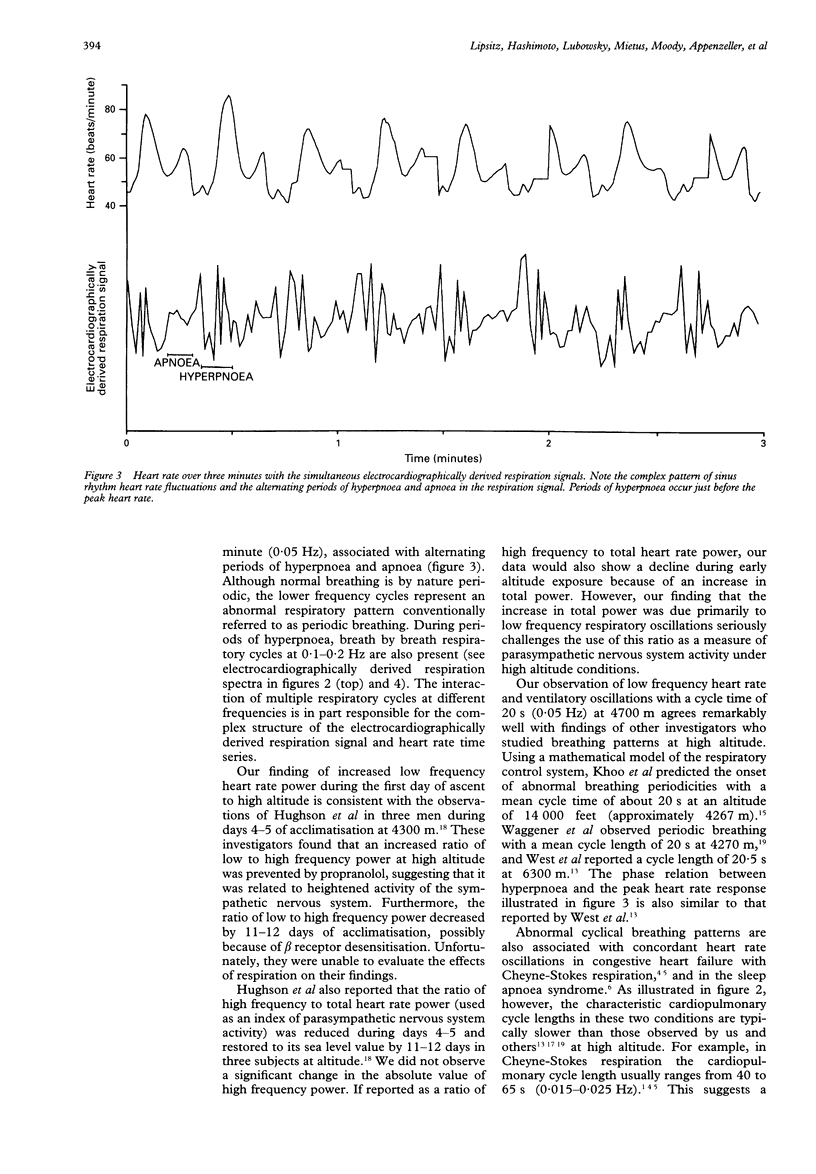
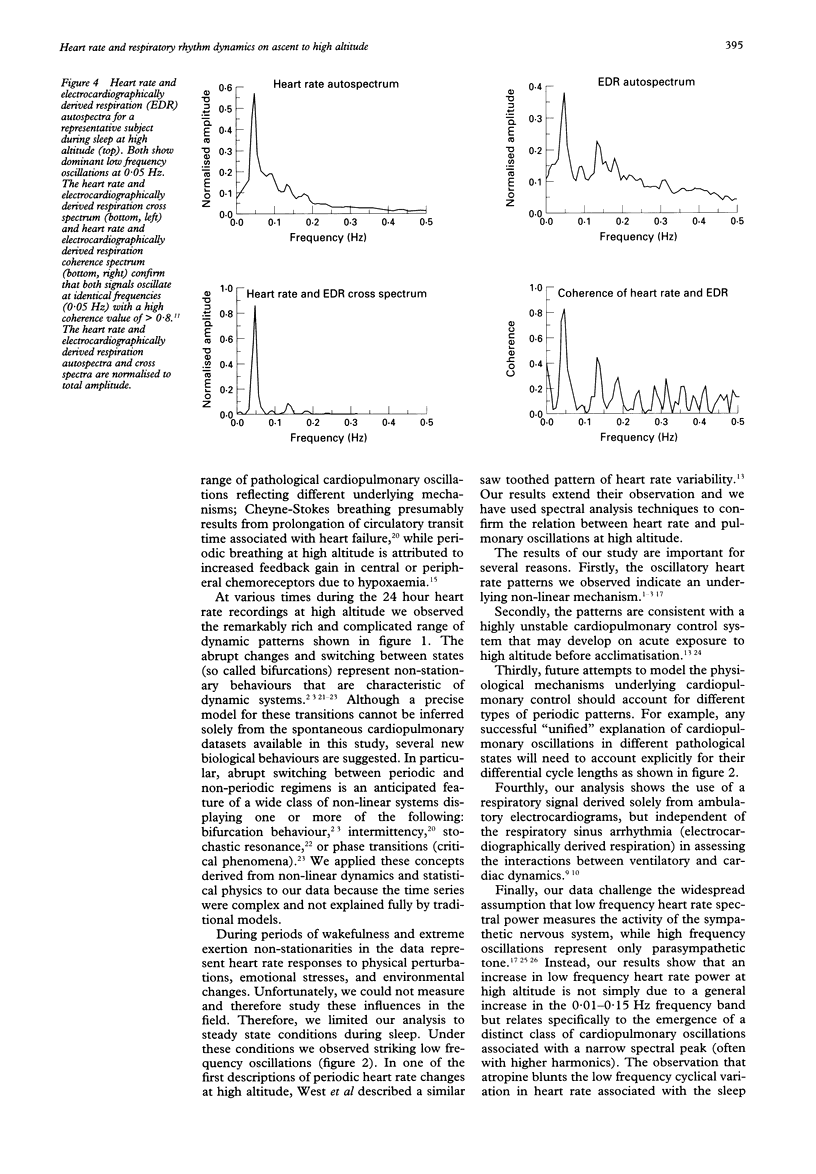
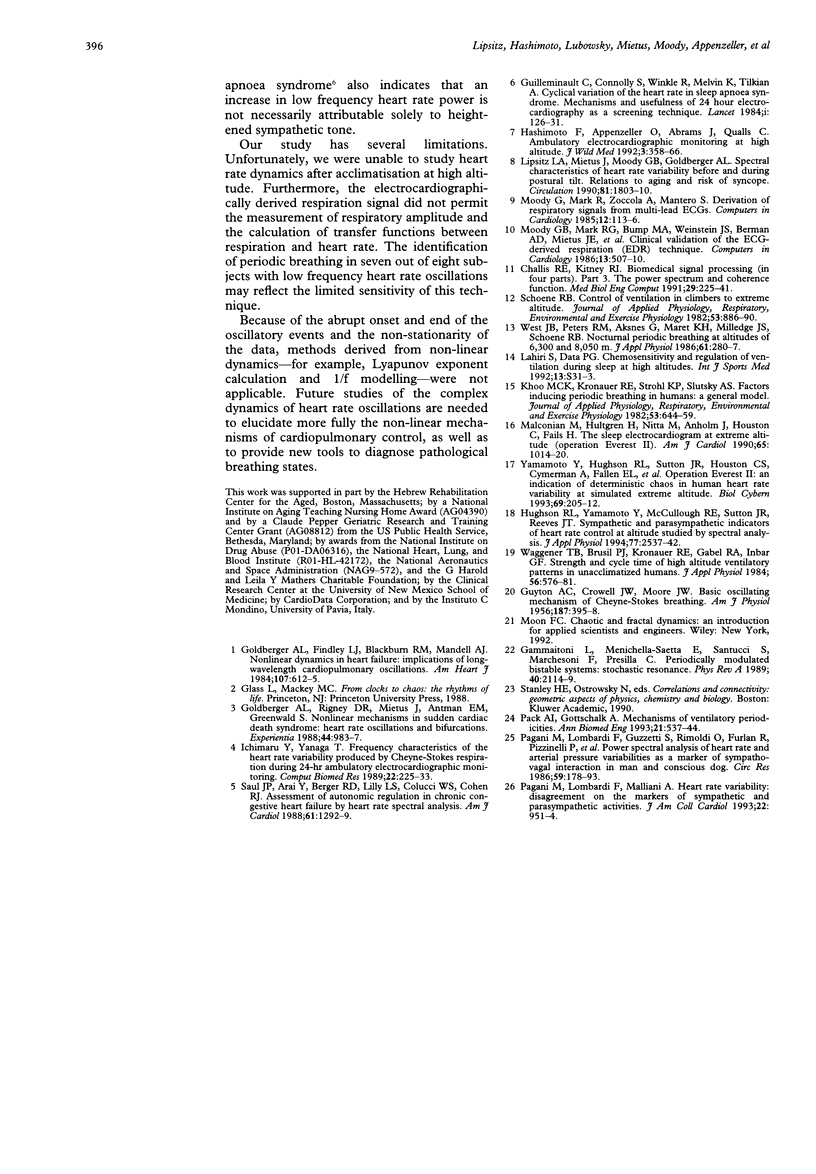
Selected References
These references are in PubMed. This may not be the complete list of references from this article.
- CROWELL J. W., GUYTON A. C., MOORE J. W. Basic oscillating mechanism of Cheyne-Stokes breathing. Am J Physiol. 1956 Nov;187(2):395–398. doi: 10.1152/ajplegacy.1956.187.2.395. [DOI] [PubMed] [Google Scholar]
- Challis R. E., Kitney R. I. Biomedical signal processing (in four parts). Part 3. The power spectrum and coherence function. Med Biol Eng Comput. 1991 May;29(3):225–241. doi: 10.1007/BF02446704. [DOI] [PubMed] [Google Scholar]
- Gammaitoni L, Menichella-Saetta E, Santucci S, Marchesoni F, Presilla C. Periodically time-modulated bistable systems: Stochastic resonance. Phys Rev A Gen Phys. 1989 Aug 15;40(4):2114–2119. doi: 10.1103/physreva.40.2114. [DOI] [PubMed] [Google Scholar]
- Goldberger A. L., Findley L. J., Blackburn M. R., Mandell A. J. Nonlinear dynamics in heart failure: implications of long-wavelength cardiopulmonary oscillations. Am Heart J. 1984 Mar;107(3):612–615. doi: 10.1016/0002-8703(84)90120-0. [DOI] [PubMed] [Google Scholar]
- Goldberger A. L., Rigney D. R., Mietus J., Antman E. M., Greenwald S. Nonlinear dynamics in sudden cardiac death syndrome: heartrate oscillations and bifurcations. Experientia. 1988 Dec 1;44(11-12):983–987. doi: 10.1007/BF01939894. [DOI] [PubMed] [Google Scholar]
- Guilleminault C., Connolly S., Winkle R., Melvin K., Tilkian A. Cyclical variation of the heart rate in sleep apnoea syndrome. Mechanisms, and usefulness of 24 h electrocardiography as a screening technique. Lancet. 1984 Jan 21;1(8369):126–131. doi: 10.1016/s0140-6736(84)90062-x. [DOI] [PubMed] [Google Scholar]
- Hughson R. L., Yamamoto Y., McCullough R. E., Sutton J. R., Reeves J. T. Sympathetic and parasympathetic indicators of heart rate control at altitude studied by spectral analysis. J Appl Physiol (1985) 1994 Dec;77(6):2537–2542. doi: 10.1152/jappl.1994.77.6.2537. [DOI] [PubMed] [Google Scholar]
- Ichimaru Y., Yanaga T. Frequency characteristics of the heart rate variability produced by Cheyne-Stokes respiration during 24-hr ambulatory electrocardiographic monitoring. Comput Biomed Res. 1989 Jun;22(3):225–233. doi: 10.1016/0010-4809(89)90003-7. [DOI] [PubMed] [Google Scholar]
- Khoo M. C., Kronauer R. E., Strohl K. P., Slutsky A. S. Factors inducing periodic breathing in humans: a general model. J Appl Physiol Respir Environ Exerc Physiol. 1982 Sep;53(3):644–659. doi: 10.1152/jappl.1982.53.3.644. [DOI] [PubMed] [Google Scholar]
- Lahiri S., Data P. G. Chemosensitivity and regulation of ventilation during sleep at high altitudes. Int J Sports Med. 1992 Oct;13 (Suppl 1):S31–S33. doi: 10.1055/s-2007-1024585. [DOI] [PubMed] [Google Scholar]
- Lipsitz L. A., Mietus J., Moody G. B., Goldberger A. L. Spectral characteristics of heart rate variability before and during postural tilt. Relations to aging and risk of syncope. Circulation. 1990 Jun;81(6):1803–1810. doi: 10.1161/01.cir.81.6.1803. [DOI] [PubMed] [Google Scholar]
- Malconian M., Hultgren H., Nitta M., Anholm J., Houston C., Fails H. The sleep electrocardiogram at extreme altitudes (Operation Everest II) Am J Cardiol. 1990 Apr 15;65(15):1014–1020. doi: 10.1016/0002-9149(90)91006-r. [DOI] [PubMed] [Google Scholar]
- Pack A. I., Gottschalk A. Mechanisms of ventilatory periodicities. Ann Biomed Eng. 1993 Sep-Oct;21(5):537–544. doi: 10.1007/BF02584336. [DOI] [PubMed] [Google Scholar]
- Pagani M., Lombardi F., Guzzetti S., Rimoldi O., Furlan R., Pizzinelli P., Sandrone G., Malfatto G., Dell'Orto S., Piccaluga E. Power spectral analysis of heart rate and arterial pressure variabilities as a marker of sympatho-vagal interaction in man and conscious dog. Circ Res. 1986 Aug;59(2):178–193. doi: 10.1161/01.res.59.2.178. [DOI] [PubMed] [Google Scholar]
- Pagani M., Lombardi F., Malliani A. Heart rate variability: disagreement on the markers of sympathetic and parasympathetic activities. J Am Coll Cardiol. 1993 Sep;22(3):951–953. doi: 10.1016/0735-1097(93)90218-p. [DOI] [PubMed] [Google Scholar]
- Saul J. P., Arai Y., Berger R. D., Lilly L. S., Colucci W. S., Cohen R. J. Assessment of autonomic regulation in chronic congestive heart failure by heart rate spectral analysis. Am J Cardiol. 1988 Jun 1;61(15):1292–1299. doi: 10.1016/0002-9149(88)91172-1. [DOI] [PubMed] [Google Scholar]
- Waggener T. B., Brusil P. J., Kronauer R. E., Gabel R. A., Inbar G. F. Strength and cycle time of high-altitude ventilatory patterns in unacclimatized humans. J Appl Physiol Respir Environ Exerc Physiol. 1984 Mar;56(3):576–581. doi: 10.1152/jappl.1984.56.3.576. [DOI] [PubMed] [Google Scholar]
- West J. B., Peters R. M., Jr, Aksnes G., Maret K. H., Milledge J. S., Schoene R. B. Nocturnal periodic breathing at altitudes of 6,300 and 8,050 m. J Appl Physiol (1985) 1986 Jul;61(1):280–287. doi: 10.1152/jappl.1986.61.1.280. [DOI] [PubMed] [Google Scholar]
- Yamamoto Y., Hughson R. L., Sutton J. R., Houston C. S., Cymerman A., Fallen E. L., Kamath M. V. Operation Everest II: an indication of deterministic chaos in human heart rate variability at simulated extreme altitude. Biol Cybern. 1993;69(3):205–212. doi: 10.1007/BF00198960. [DOI] [PubMed] [Google Scholar]


